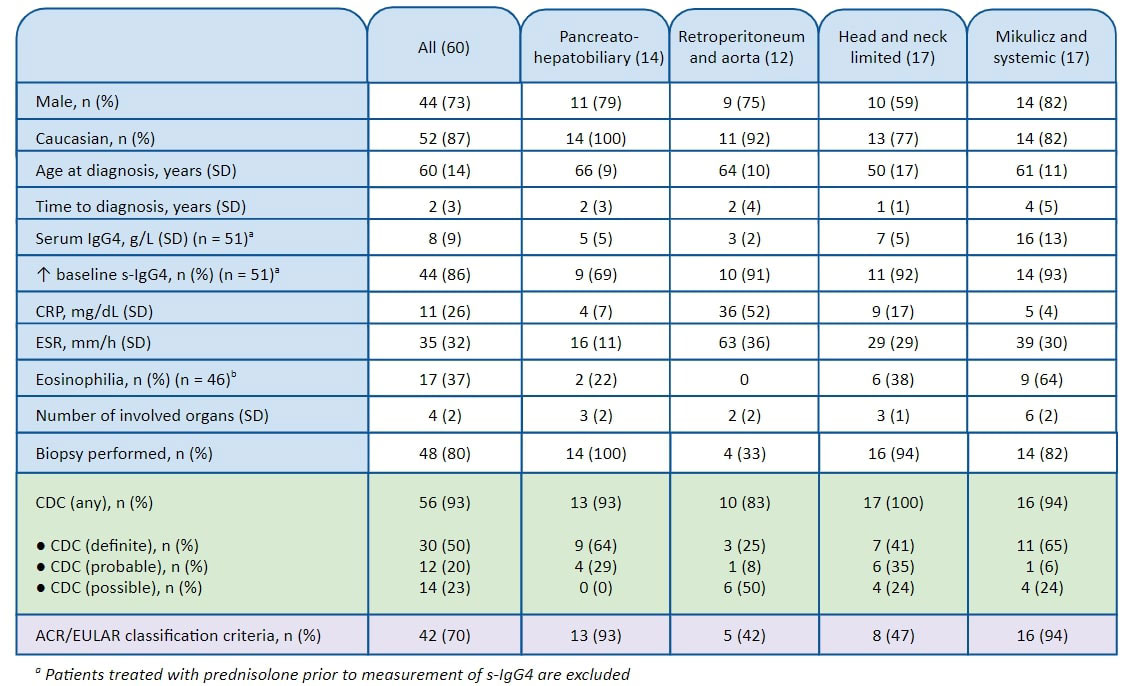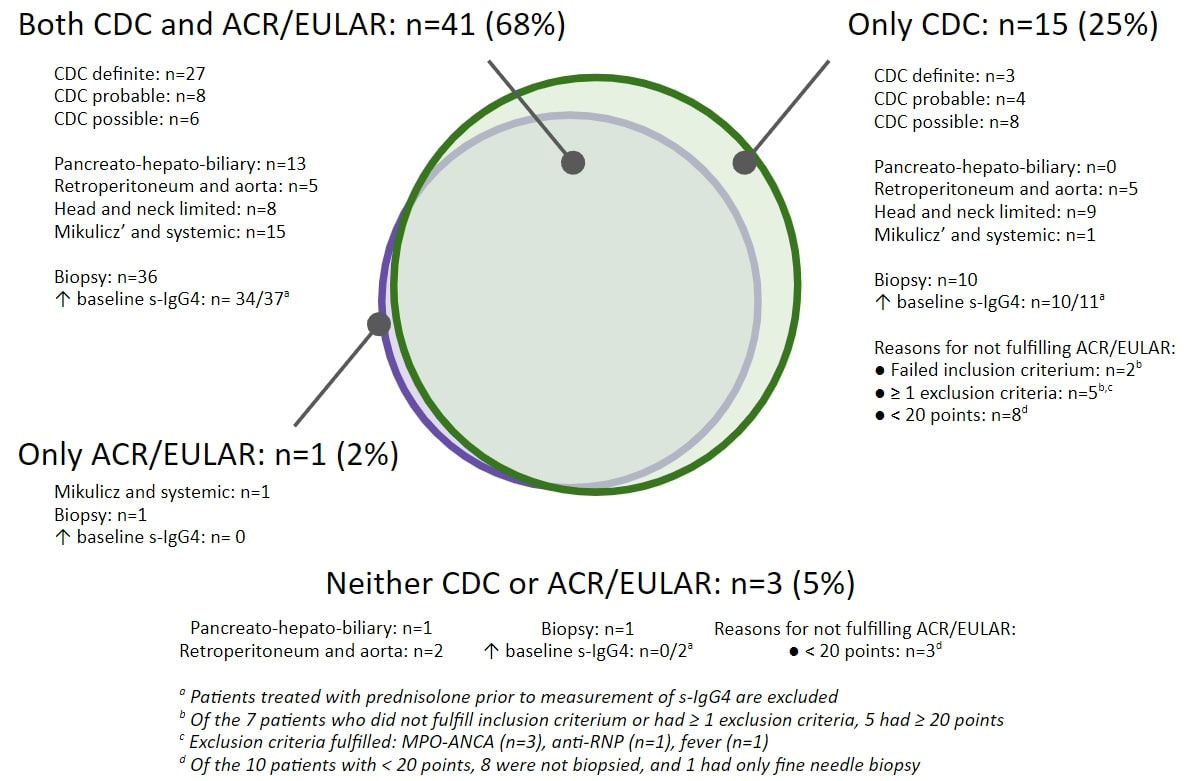Session Information
Session Type: Poster Session D
Session Time: 1:00PM-3:00PM
Background/Purpose: Milestones in the field of IgG4-related disease (IgG4-RD) include the 2011 Comprehensive Diagnostic Criteria (CDC), the 2019 ACR/EULAR classification criteria, and the recent identification of four distinct clinical phenotypes. Performance of the criteria and phenotypic disease expression in Scandinavian populations are largely unknown. We aimed to describe disease characteristics, phenotypes, and performance of the 2011 CDC and 2019 ACR/EULAR classification criteria in patients with IgG4-RD in Norway.
Methods: Consenting, adult patients with a clinical diagnosis of IgG4-RD, seen at the Department of Rheumatology, Oslo University Hospital were included. Two experts (JV, ØMi) assigned patients to phenotypes (“Pancreato-Hepato-Biliary”, “Retroperitoneum and Aorta”, “Head and Neck-Limited” or “Mikulicz and Systemic”) based on pattern of organ involvement. Fulfillment of the CDC and ACR/EULAR classification criteria were assessed. Disease activity and damage were scored with the IgG4-RD responder index (IgG4-RD RI). We used descriptive statistics.
Results: We identified 60 patients with IgG4-RD (Table 1). Clinical characteristics were as expected, with approximately equal number of patients in each phenotype group. Of all patients diagnosed by expert opinion, 42 (70%) fulfilled the ACR/EULAR classification criteria. Reasons for not fulfilling the criteria were (i) failure to meet the inclusion criterium (n = 2) due to “atypical” organ involvement: nasal cavity (n = 1), coronary artery (n = 1); (ii) presence of ≥ 1 exclusion criterium (n = 5): fever (n = 1), leukopenia (n = 1), thrombocytopenia (n = 1), positive anti-MPO-ANCA (n = 3), anti-SSA (n = 1) and/or anti-RNP (n = 1) antibody; and (iii) score < 20 points (n = 11). In the latter group, 8 (73%) were not biopsied, and 1 (9%) had only performed fine needle biopsy. Among the patients not meeting the inclusion criterium or having ≥ 1 exclusion criteria, 1 (33%) and 4 (80%) scored ≥ 20 points, respectively. Of all patients, 56 (93%) fulfilled CDC, with 30 (50%), 12 (20%) and 14 (23%) patients characterized as “definite”, “probable” and “possible” IgG4-RD, respectively. Of the 18 patients not fulfilling the ACR/EULAR classification criteria, 15 (83%) fulfilled CDC (3 “definite”, 4 “probable”, 8 “possible”). Of the 4 patients not fulfilling CDC, 1 fulfilled the ACR/EULAR classification criteria.
Conclusion: Despite expected clinical characteristics, phenotype distribution and fulfilment of CDC in our cohort, the performance of the ACR/EULAR classification criteria was lower than expected, especially in the “Retroperitoneum and Aorta” and “Head and Neck-Limited” phenotypes. Limited evidence suggest that these phenotypes are more treatment refractory. Hence, through a relatively lower ability to capture these patients, the ACR/EULAR classification criteria may be in danger of favoring a subset of patients with more treatment responsive disease, potentially resulting in falsely inflated response rates in clinical trials.
To cite this abstract in AMA style:
Vikse J, Midtvedt O, Molberg O, Fevang B, Palm O, Garen T, Norheim K, Bakland G, Wallenius M, Hoffmann-Vold A. The 2019 ACR/EULAR Classification Criteria for IgG4-Related Disease Perform Lower Than Expected: Data from a Norwegian Cohort [abstract]. Arthritis Rheumatol. 2022; 74 (suppl 9). https://acrabstracts.org/abstract/the-2019-acr-eular-classification-criteria-for-igg4-related-disease-perform-lower-than-expected-data-from-a-norwegian-cohort/. Accessed .« Back to ACR Convergence 2022
ACR Meeting Abstracts - https://acrabstracts.org/abstract/the-2019-acr-eular-classification-criteria-for-igg4-related-disease-perform-lower-than-expected-data-from-a-norwegian-cohort/


